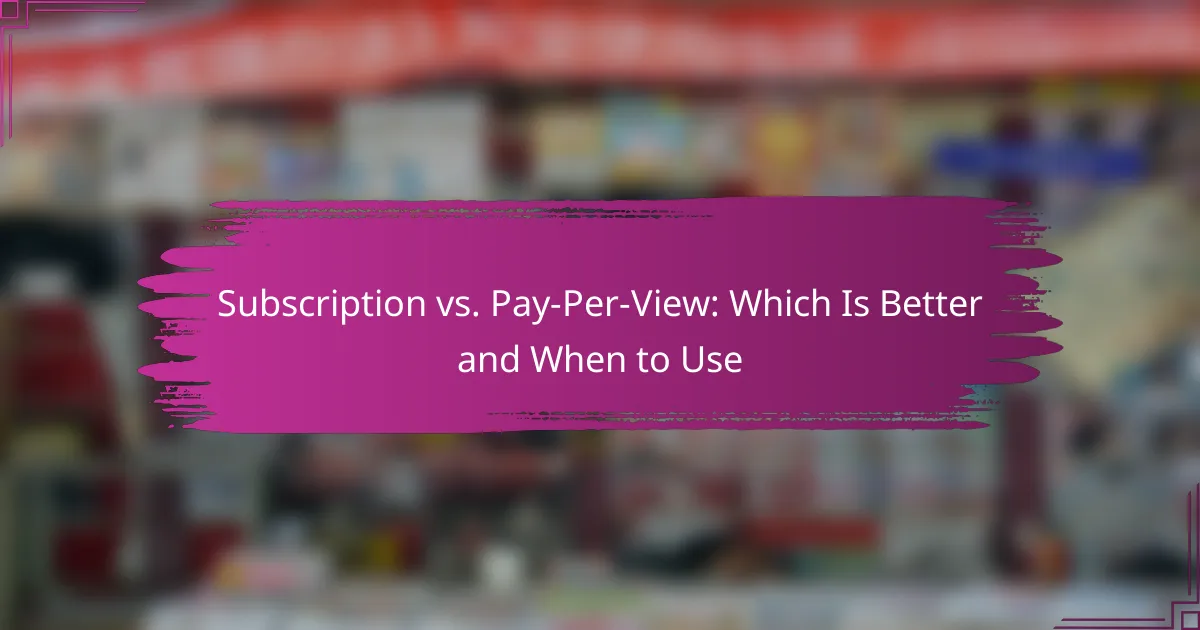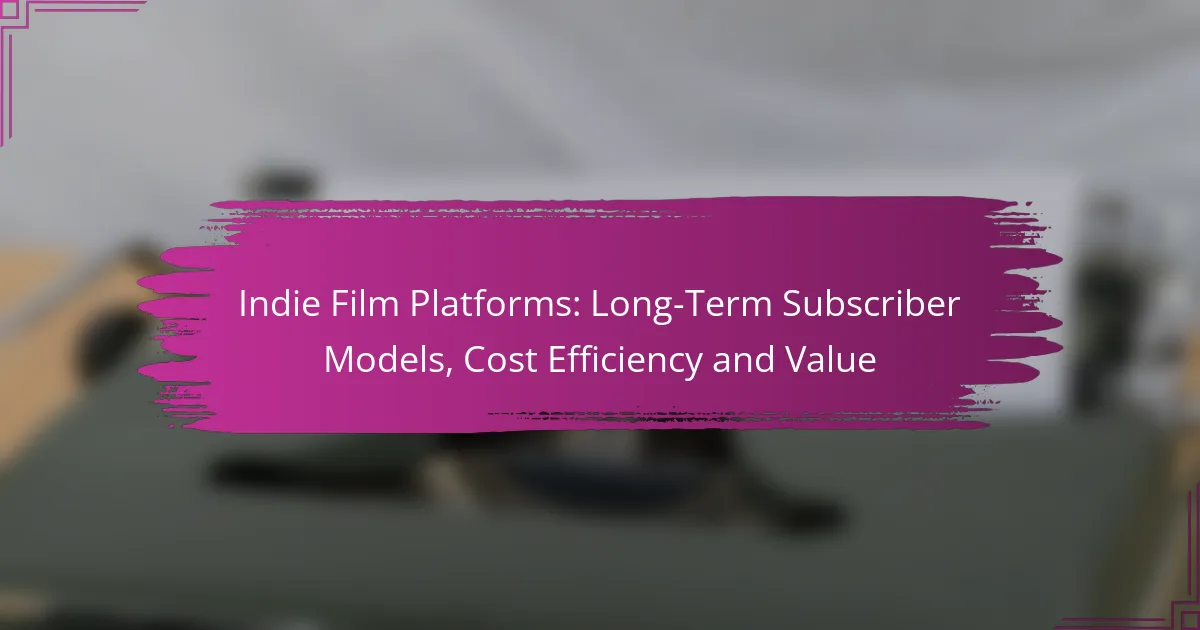When deciding between Subscription and Pay-Per-View (PPV) models, it’s essential to understand their distinct advantages. Subscriptions offer unlimited access for a recurring fee, making them perfect for frequent viewers, while PPV allows users to pay only for specific content, catering to those who prefer flexibility and occasional viewing. This guide will help you determine which option best suits your viewing habits and preferences.
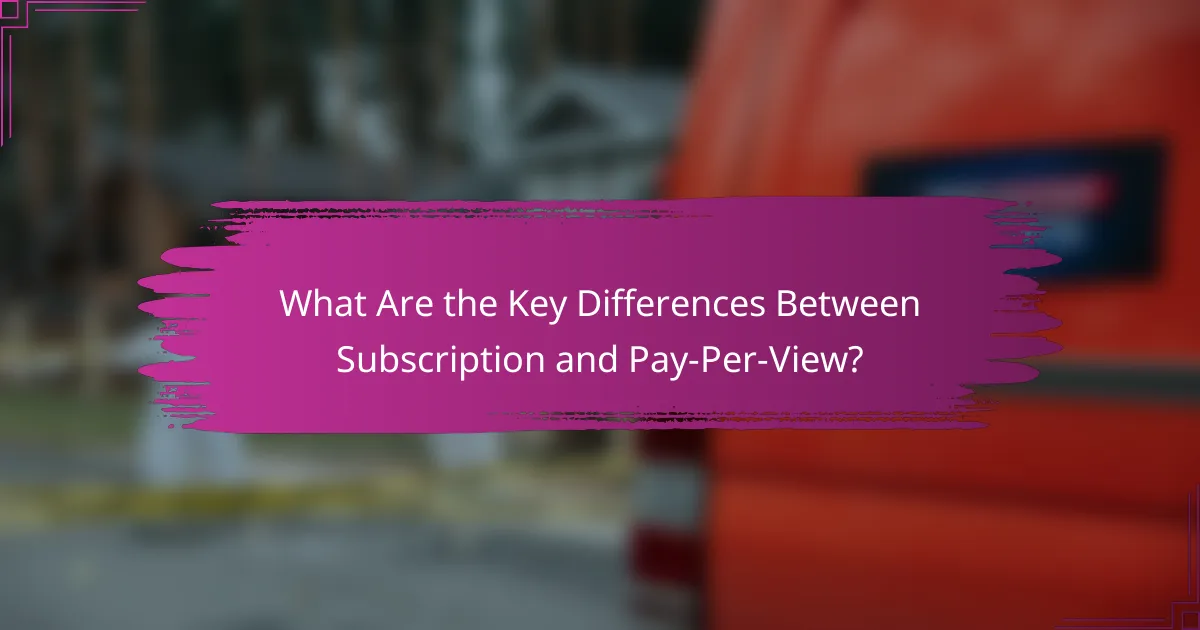
What Are the Key Differences Between Subscription and Pay-Per-View?
Subscription and Pay-Per-View (PPV) are two distinct payment models for accessing content. Subscriptions typically involve a recurring fee for unlimited access, while PPV requires users to pay for each individual piece of content they wish to view.
Payment structure
The payment structure for subscriptions usually involves a monthly or annual fee, allowing users to access a wide range of content without additional costs. In contrast, Pay-Per-View charges users on a per-event basis, meaning they only pay for specific content they choose to watch.
This difference can significantly impact budgeting. For example, a subscription service might cost around $10 to $15 per month, while a single PPV event could range from $5 to $100, depending on the content’s exclusivity and popularity.
Content access
With a subscription model, users gain access to a library of content that is regularly updated, including movies, shows, and live events. This model is ideal for viewers who consume a lot of content regularly.
On the other hand, Pay-Per-View offers access to specific events, such as live sports or exclusive premieres, which may not be available through subscription services. Users pay only for what they want to watch, but they may miss out on a broader selection of content.
User commitment
Subscriptions often require a longer-term commitment, as users may sign up for several months or even a year. This can lead to savings if users frequently watch content, but it may also result in paying for months of service when not actively watching.
Pay-Per-View, however, allows for more flexibility, as users can choose to pay only when they want to watch specific content. This model is beneficial for occasional viewers who prefer not to commit to ongoing payments.
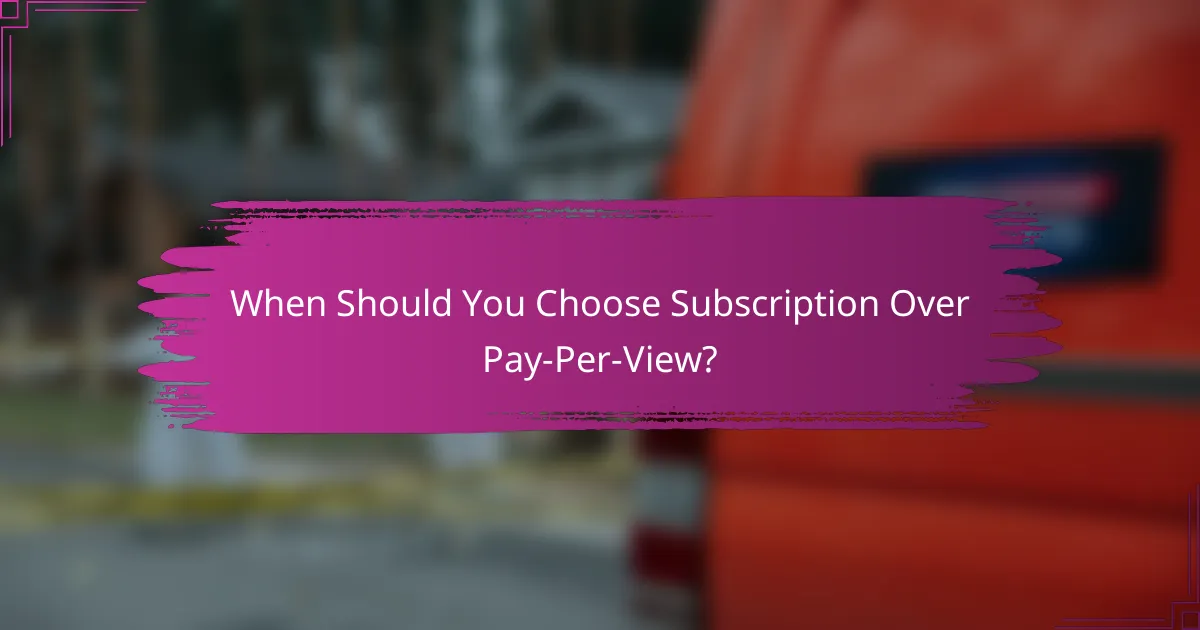
When Should You Choose Subscription Over Pay-Per-View?
Choosing a subscription model is ideal when you anticipate consuming content frequently. Subscriptions provide access to a library of content for a fixed monthly or annual fee, making them suitable for regular viewers who want to avoid multiple individual charges.
Frequent content consumption
If you watch content regularly, a subscription service is often the best choice. For example, platforms like Netflix or Hulu offer extensive libraries that cater to binge-watchers, allowing unlimited access to shows and movies for a single fee. This model is particularly beneficial for those who enjoy series or ongoing events, as it eliminates the hassle of paying for each individual piece of content.
Consider your viewing habits: if you find yourself watching multiple shows or films each week, a subscription can save you time and money compared to pay-per-view options.
Cost-effectiveness for regular viewers
Subscriptions can be more cost-effective for regular viewers compared to pay-per-view. For instance, if a pay-per-view event costs around $20 and you watch several events a month, your costs can quickly add up. In contrast, a subscription might range from $10 to $15 monthly, allowing access to a wide array of content for less than the price of two pay-per-view events.
When evaluating options, consider how many events or shows you typically watch. If you regularly consume content, a subscription will likely provide better value and convenience.
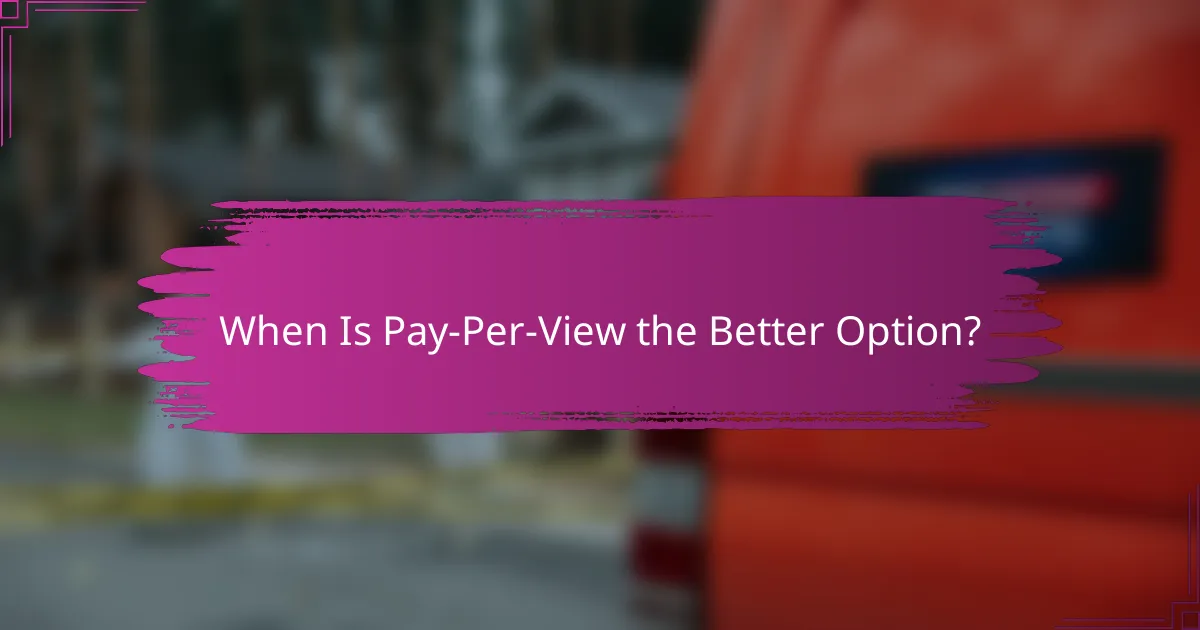
When Is Pay-Per-View the Better Option?
Pay-Per-View (PPV) is often the better choice for viewers who want flexibility and access to specific content without a long-term commitment. It allows consumers to pay only for what they watch, making it ideal for occasional viewers or those interested in unique events.
Occasional viewing needs
If you watch sports, movies, or shows infrequently, Pay-Per-View can save you money compared to a subscription service. For example, if you only watch a few major boxing matches or UFC events each year, paying for those specific events might be more economical than maintaining a monthly subscription.
Consider your viewing habits. If you find yourself watching only a handful of events or shows annually, PPV allows you to enjoy content without the ongoing costs associated with subscriptions. This approach can be particularly beneficial for those who prefer not to commit to regular payments.
Special events or exclusive content
Pay-Per-View is an excellent option for accessing special events or exclusive content that isn’t available through regular channels. Events like championship fights, concerts, or premieres often come with a PPV option, allowing fans to experience them live from home.
When deciding on PPV for special events, check the pricing and availability in your region. Prices can vary significantly, often ranging from $20 to $100 or more, depending on the event’s exclusivity and demand. Make sure to book in advance to secure your access and avoid last-minute issues.

What Are the Pros and Cons of Each Model?
Subscription and pay-per-view (PPV) models each have distinct advantages and disadvantages that can affect user experience and cost. Understanding these can help you choose the best option for your viewing preferences and budget.
Advantages of subscription
Subscriptions typically offer unlimited access to a wide range of content for a fixed monthly fee, making them cost-effective for frequent viewers. Services like Netflix and Spotify allow users to explore diverse libraries without incurring additional charges per title.
Another advantage is the convenience of predictable billing. Users can budget their entertainment expenses easily, knowing exactly how much they will pay each month. This model often includes exclusive content that is not available through other channels.
Disadvantages of subscription
One downside of subscription services is that they may require a long-term commitment, which can be a drawback for occasional viewers. If you only watch a few shows or events, paying a monthly fee may not be justified.
Additionally, content libraries can change frequently, with titles being added or removed, which may lead to frustration if a favorite show is no longer available. Users might also find themselves paying for multiple subscriptions to access all desired content.
Advantages of pay-per-view
Pay-per-view allows users to pay only for the specific content they want to watch, making it ideal for occasional viewers or those interested in specific events, such as sports matches or movie premieres. This model can save money for users who do not watch content regularly.
PPV also provides immediate access to new releases, often on the same day they become available. This is particularly appealing for fans eager to watch the latest blockbuster without waiting for it to appear on subscription platforms.
Disadvantages of pay-per-view
The main disadvantage of pay-per-view is the potential for high costs if users frequently purchase individual titles or events. Each transaction can add up quickly, leading to unexpected expenses.
Moreover, PPV typically lacks the extensive content libraries found in subscription models, limiting options for users who enjoy exploring various genres. This can lead to a less satisfying viewing experience for those seeking variety.

How Do Major Platforms Implement These Models?
Major platforms utilize subscription and pay-per-view models to cater to different audience preferences and content types. Subscription services provide ongoing access for a regular fee, while pay-per-view allows users to purchase access to specific events or content on a one-time basis.
Netflix subscription model
Netflix operates on a subscription model, offering users unlimited access to a vast library of movies, series, and documentaries for a monthly fee. This model encourages binge-watching and fosters viewer loyalty, as subscribers can enjoy a wide range of content without additional costs.
Netflix typically offers tiered pricing plans, allowing users to choose based on their needs, such as the number of simultaneous streams or video quality. This flexibility can range from around $10 to $20 per month, depending on the selected plan.
UFC pay-per-view events
The UFC employs a pay-per-view model for its major fight events, charging viewers a one-time fee to access live broadcasts. This approach capitalizes on high-profile matches, where fans are willing to pay a premium for exclusive access to live sports entertainment.
Prices for UFC pay-per-view events generally range from $60 to $80, depending on the event’s significance. This model can be lucrative, as it generates substantial revenue from dedicated fans who want to watch specific fights without committing to a subscription service.

What Factors Should You Consider When Choosing a Model?
When deciding between subscription and pay-per-view models, consider factors such as audience preferences, content type, and revenue goals. Each model has distinct advantages and trade-offs that can significantly impact your overall strategy.
Audience Preferences
Understanding your audience’s viewing habits is crucial. Subscribers often prefer unlimited access to a library of content, while pay-per-view users may favor flexibility and only pay for specific events or shows. Conduct surveys or analyze viewing data to gauge what your audience values more.
For example, sports fans might lean towards pay-per-view for major events, while movie buffs may prefer a subscription service that offers a wide range of films. Tailoring your model to these preferences can enhance user satisfaction and retention.
Content Type
The nature of your content plays a significant role in choosing a model. If you produce exclusive, high-demand content, a pay-per-view approach might maximize revenue per view. Conversely, if your content is more general or has a longer shelf life, a subscription model could provide steady income over time.
Consider the lifecycle of your content. Live events or new releases may benefit from pay-per-view, while a vast library of older films or series could thrive under a subscription model. Assessing content type helps in aligning your strategy with audience expectations.
Revenue Goals
Your financial objectives will influence the choice between subscription and pay-per-view. Subscription models typically provide predictable, recurring revenue, which can be beneficial for budgeting and planning. Pay-per-view can yield higher short-term revenue spikes, especially during high-profile events.
Evaluate your cash flow needs and long-term goals. If immediate revenue is critical, pay-per-view might be the way to go. However, if you aim for sustainable growth, a subscription model could offer more stability. Balancing these goals is essential for long-term success.
